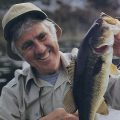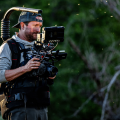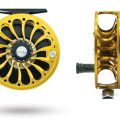Chasing Northerns: “Trust But Verify”
 “The setup is a fly-in only camp. They are the only outfitter on a lake that’s twenty five miles long and three miles wide! The only competition we’ll have are the spin casters and the damn eagles!”
“The setup is a fly-in only camp. They are the only outfitter on a lake that’s twenty five miles long and three miles wide! The only competition we’ll have are the spin casters and the damn eagles!”
I said thanks but no thanks.
A longtime fishing companion had just contacted me about joining in with a group for a fishing adventure, and I almost always jump in on such an offer. My decision to turn it down flies in the face of all my fish loving instincts. They were traveling to one of the prettiest places on the planet, Northeast Manitoba, in pursuit of big northern pike.
The trip was scheduled for late July, what I consider late for big pike prime time. Experience told me that the fish had dispersed from their spawning areas and had spread throughout the lake, now stalking the weed beds and the rocky windblown shorelines in search of their next meal. Tracking down the bruisers at this time of the year would be a difficult challenge. Recalling my last pike adventure from long ago, I thought my expectations might be a bit much.
Back in the early 90s, I began hearing some noise about the pursuit of northern pike with a fly rod. My angling gang was always digging around to find new and different types of pursuit via fly fishing and this one sounded too interesting. I did my research and reached out to Barry Reynolds, author of “Pike on the Fly.” After an enlightening conversation with Barry and at his invitation, my fly fishing mentors and I committed to booking our trip at an established pike angling camp on Lake Wollaston, Northern Saskatchewan. That was a great fishing surprise too many years ago.
For the best chance of connecting with a big, aggressive, muscle bound, multi-toothed fly smashing torpedo it often means being on the water at the right time. That usually being just after the surface ice has melted off, or “ice out.” If you get the timing right, pike fishing the ice out means good sight fishing to big fish, usually sometime in early June in the upper Canadian regions, weather dictating. At this time of year, the females are in search of optimal water temperatures to commence and complete their spawn. This also means they stack up in the back of the bays and sloughs where any contributing finger, creek or estuary with warm water run-off is trickling in for the desired breeding and feeding temperatures they seek. Our first venture at chasing down these voracious hunters was an eye- opening success and about as much fun as you can have with your clothes on.
So now, another chance at chasing big pike has come about…and even though I said I would take a pass on this invite, I kept asking questions.
Maybe I should have stuck to my guns, bit in recalling the big picture, I was glad I didn’t. Taking into account what an old fart I have become, I agreed to join in; knowing these guys are too much fun to fish with. I continued asking questions, but in the end, not really enough.
 A couple of Q&A sessions in our well-established angling conference center, also known as Krueger’s Bar, got me and the boys pretty excited. Putting together the list of fly gear we’d need absolutely sealed the deal. Along with all the ancillary necessities, (booze — dry camp), we set ourselves up with 8, 9 and 10 weight sticks, mating those rods with big-bellied weight forward shooting head lines. These lines being designed for throwing the big, wind resistant kites and wet sock imitations we planned on casting. We had confidence that the gear was covered: floating lines, sinking lines, hard mono and fluoro leaders, floating and sinking. Braided leaders, 40- to 80-pound mono and wire bite tippet. We were keeping the local fly shops happy.
A couple of Q&A sessions in our well-established angling conference center, also known as Krueger’s Bar, got me and the boys pretty excited. Putting together the list of fly gear we’d need absolutely sealed the deal. Along with all the ancillary necessities, (booze — dry camp), we set ourselves up with 8, 9 and 10 weight sticks, mating those rods with big-bellied weight forward shooting head lines. These lines being designed for throwing the big, wind resistant kites and wet sock imitations we planned on casting. We had confidence that the gear was covered: floating lines, sinking lines, hard mono and fluoro leaders, floating and sinking. Braided leaders, 40- to 80-pound mono and wire bite tippet. We were keeping the local fly shops happy.
For each of us I tied a box containing various colors and patterns of oversized poppers, big articulated sliders along with Bunny Bugs, foot long streamers, many with pulse discs and rattles. Deep running imitations (of what is debatable) with a ridiculous amount of flash and tail. Some were tied dull and gray and brown and short. Gotta’ cover the bases. The big pike mandate big baitfish patterns so I added a few creations of my own design that I hoped would generate something other than WTF looks from the boys. I wanted to make sure there was an offering for all conditions, including the ones we hoped for but were yet unknown.
We were ready. Or so we thought.
After 21 straight hours of airline travel and driving, we arrived at a nondescript motel somewhere in northern Manitoba. Following a short night’s rest, we crawled aboard the pre-dawn charter flight to our final destination. (It may be of interest here to note that a buddy recently made the trip from Chicago to the Seychelles in less time.) We landed on a tight, grassy strip surrounded by deep forest and, slithering out of the plane, I could readily smell the big body of water nearby. Our gear was hauled to our cabins and after brief introductions at the lodge, we hammered down breakfast and got geared up.
Time to go fishing! Right?
Upon arriving at the dock, it was hard to miss some of the interesting reactions to our chosen method of pike pursuit. “I don’t want nuthin’ to do with that fly fishing shit,” noted one of the guides. “You can’t catch a big Northern on a fly rod,” said another.
Uh oh. These guys weren’t screwing with us…they were serious…this could be a long trip.
So it goes in the outfitted fishing industry.
I had had considerable success chasing northerns with a fly rod some 26 years back, now I was getting spooked and worried. Also, admittedly, somewhat steamed. But what’s a fly angler to do at this point? After humping our gear into the boat, our guide took hold of my trusty 8-weight, waved it back and forth, looked at me with a wry grin and proclaimed, “There aren’t any trout in this lake!” Funny guy.
I figured my, “Uh oh,” just received confirmation.
Turns out Kenny the guide enjoys screwing with the new sports, one of his specialties. Lucky for us he was quite knowledgeable in the ways and means of the long rod. We ended up being quite grateful he was.
After a 30-minute blast across a long bay Kenny motored our John Boat into a deep windless cove for our first hour out. With the sun directly overhead, he shut down the outboard and finished it out with the paddle. With the surface glassed over, I gave a hard look into the tannin colored water, noting the weed bed that extended along the shoreline for hundreds of yards running down to an 8-foot bottom, sometimes a bit deeper. Now I got the juices going.
I won “rock-paper-scissors” for first up (I almost always do because I know how to cheat) and just a few casts later our modest length quarry was launching itself four feet into the air, missing my big popper. I finished the retrieve, chucked it back out there and this time Mr. Northern hammered it.
Good start, the skunk is out early.
When you are stripping a noisy slider back and you spot three separate wakes screaming toward your presentation, it is hard to keep one’s composure. When hooking up with a pike of even modest size they just keep pulling, violently at first until tiring and then trying to settle on the bottom to sulk. Raising them to the boat is like hauling up a kids playground bucket full of sand…then they see the boat and, with a lot of thrashing and splashing, the drill starts again. One of my companions lost a fish Kenny estimated to be over four feet long on a lazy action slider he was softly dancing on the surface.
 Pike put up a serious rod-bender of a fight, but usually not of the “spool you” ilk. With these fish, so much of it is about the strike. Periodically while on the water, one will spot a big pike floating dead on the surface with a three-foot version of itself sticking halfway out of its mouth, biting off more than it could swallow. Barry Reynolds notes that one of the things he loves the most about pike fishing is “they strike with very bad intentions.” Indeed.
Pike put up a serious rod-bender of a fight, but usually not of the “spool you” ilk. With these fish, so much of it is about the strike. Periodically while on the water, one will spot a big pike floating dead on the surface with a three-foot version of itself sticking halfway out of its mouth, biting off more than it could swallow. Barry Reynolds notes that one of the things he loves the most about pike fishing is “they strike with very bad intentions.” Indeed.
Returning to the dock that first evening, we found our discouraged companion, JH, already back. He relayed to us that he had only caught a couple of small fish after partnering with a long time camp client who was spin casting. There wasn’t a lot of consideration for the guy who wanted to fish a different way. He would make a request for help regarding wind or fly color or depth to fish, his guide would simply grunt back at him, staying at anchor. My pal would relinquish his turn on deck out of frustration more than a few times that day.
The next day, and after a discussion with the lodge owner, all three fly rodders ended up in the same boat for the duration of our week long trip.
For our remaining days, we got into the rhythm of sharing one boat. Patiently taking turns on next up, always making sure to continue harassing the guy on deck about his casting or a missed hook-up. When situations like this drop in for a visit, 30+ years of fishing together can make all the difference, in a good way.
While working surface offerings, we were also catching lunch, aka walleye. A bit unusual on top but a real hoot. Returning to the dock that evening, Kenny was sharing some recordings he shot of our Walleye top-water catches.
“I didn’t think you could catch a Walleye with a fly rod!”
This statement would come from the owner of the camp and really strike home with us.
I wondered…how do the fish know that you are using a fly rod?
Such statements once again (with myself and others) raised the topic of what an outfitter claims and what they deliver, a subject that we “fly guys,” as we were now known, continued to bang around each evening. This particular camp clearly stated in their brochure and website and even during a phone conversation with the owner, that they were well versed in the use of fly tackle and the needs of those using it.
If you’ve fished long enough, you’ve learned that sales and marketing claims versus the reality of the fishing situation can often be two very different things. When it comes to making the sale, many lodges and outfitters readily tell you whatever you want to hear. When reviewing this potential trip, we’d been assured that using fly gear was very effective and that the guides were familiar and even eager to fish with it. Now, as customers paid in full, we were experiencing a very different situation. Once your cash is out there, well, I hope you know how that works.
Over the years, our group of fishing knuckleheads has been sold a bill of goods more than a few times. We were promised sight fishing and nonstop topwater action for peacocks in Brazil. It didn’t happen; everything was underneath. We took a 90-minute helicopter ride deep into the “untracked” wilderness of British Columbia only to find another lodge located directly across the river from our camp and fishing the same water. “We have Bonefish here that have never seen a fly.” Right, all 3 of them. Yeah, and we’re not alone on this issue, either. This is not about the “You should have been here last week!” stuff.
So what’s a poor fly fisherman to do?
The old saying holds up: “If it sounds too good to be true, it probably is too good to be true.” Ask questions, tough questions, endless questions. Ask for references. Talk to people who have actually been there and fished that. Is it really as good as advertised? When is the best time to go? What are the downsides? Would you go again? Should you go at all? Is that kind of fishing better somewhere else? Is it worth the price?
Before bucking up your hard-earned cash, confirm and make sure it really is what they say it is. For many it may very well be the trip, and cash outlay, of a lifetime.
My observations here are not intended to bash the endless offerings of travel and outfitting services that are out there. I have been on some amazing adventures that absolutely wowed our group, and we have returned because they delivered what they claimed.
We saw our summer pike fishing adventure as a success. Our preparedness and willingness to adapt to the situation allowed it to go that way. We covered our bases and hoped for the best, landing somewhere in the middle. Fishing for these big predators is a unique and wild experience. If you ever get the chance to chase a big Northern, follow through; you won’t regret it.
Before making a big money layout on a fishing trip, perform your due diligence, talk to people who really know, ask an annoying number of questions, have high standards and high expectations. Should they not work as hard to earn your money as you did?
You won’t regret that part, either.
Dave Gulick, Jonathan Heitner, and Jeff Miller also contributed to this article.











